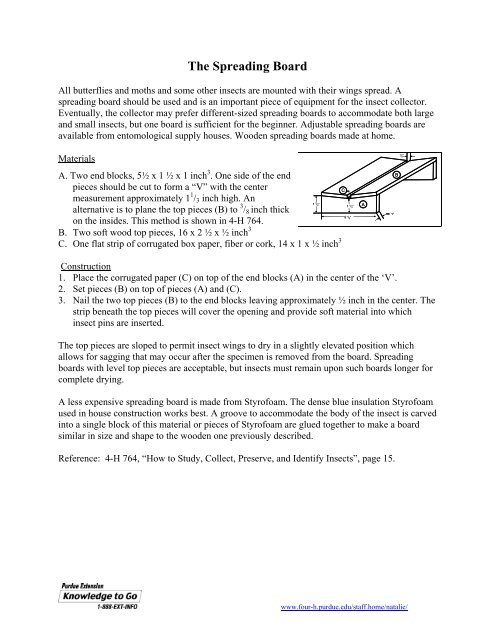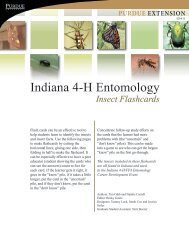The Spreading Board - Purdue Extension Entomology
The Spreading Board - Purdue Extension Entomology
The Spreading Board - Purdue Extension Entomology
Create successful ePaper yourself
Turn your PDF publications into a flip-book with our unique Google optimized e-Paper software.
<strong>The</strong> <strong>Spreading</strong> <strong>Board</strong><br />
All butterflies and moths and some other insects are mounted with their wings spread. A<br />
spreading board should be used and is an important piece of equipment for the insect collector.<br />
Eventually, the collector may prefer different-sized spreading boards to accommodate both large<br />
and small insects, but one board is sufficient for the beginner. Adjustable spreading boards are<br />
available from entomological supply houses. Wooden spreading boards made at home.<br />
Materials<br />
A. Two end blocks, 5½ x 1 ½ x 1 inch 3 . One side of the end<br />
pieces should be cut to form a “V” with the center<br />
measurement approximately 1 1 C<br />
/ 3 inch high. An<br />
alternative is to plane the top pieces (B) to 3 1<br />
/ 8 inch thick<br />
1 / 2”<br />
on the insides. This method is shown in 4-H 764.<br />
B. Two soft wood top pieces, 16 x 2 ½ x ½ inch 3<br />
C. One flat strip of corrugated box paper, fiber or cork, 14 x 1 x ½ inch 3<br />
1 1 / 3 ”<br />
5 1 / 2 ”<br />
A<br />
1 / 2”<br />
B<br />
1”<br />
Construction<br />
1. Place the corrugated paper (C) on top of the end blocks (A) in the center of the ‘V’.<br />
2. Set pieces (B) on top of pieces (A) and (C).<br />
3. Nail the two top pieces (B) to the end blocks leaving approximately ½ inch in the center. <strong>The</strong><br />
strip beneath the top pieces will cover the opening and provide soft material into which<br />
insect pins are inserted.<br />
<strong>The</strong> top pieces are sloped to permit insect wings to dry in a slightly elevated position which<br />
allows for sagging that may occur after the specimen is removed from the board. <strong>Spreading</strong><br />
boards with level top pieces are acceptable, but insects must remain upon such boards longer for<br />
complete drying.<br />
A less expensive spreading board is made from Styrofoam. <strong>The</strong> dense blue insulation Styrofoam<br />
used in house construction works best. A groove to accommodate the body of the insect is carved<br />
into a single block of this material or pieces of Styrofoam are glued together to make a board<br />
similar in size and shape to the wooden one previously described.<br />
Reference: 4-H 764, “How to Study, Collect, Preserve, and Identify Insects”, page 15.<br />
www.four-h.purdue.edu/staff.home/natalie/
1 / 2 ”<br />
B<br />
C<br />
1 1 / 2 ”<br />
1 1 / 3 ”<br />
A<br />
5 1 / 2 ”<br />
1”<br />
www.four-h.purdue.edu/staff.home/natalie/

















